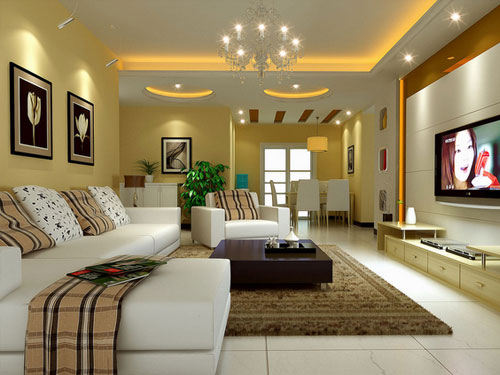The wall is one of the essential elements that define and frame a space. As a vertical surface, it plays a crucial role in shaping the visual experience of a room. When designing walls, every element—such as doors, windows, lighting fixtures, ventilation openings, and decorative details—should be integrated into a cohesive whole. Only through this organic connection can a harmonious and unified design be achieved.

**Wall Design**
When it comes to wall treatment, the most important aspect is how doors and windows are arranged. Doors and windows are "virtual" elements, while walls are "real." The way these openings are organized reflects the balance between the real and the virtual. Each wall may have different characteristics—some may be more open, others more solid, or a mix of both. It’s important to avoid a uniform or half-and-half distribution of virtual and real elements, as this can create visual imbalance.
Additionally, it's essential not to treat doors and windows as isolated features. Instead, they should be integrated into a larger design system—either vertical or horizontal divisions. This approach helps reduce their individuality and creates a more structured, orderly appearance. Typically, shorter walls work well with vertical divisions, which can add energy and movement, while taller walls benefit from horizontal divisions, offering a sense of stability and calm.
Beyond the contrast between solid and void, the repetition and alternation of windows and walls can also create a visually pleasing rhythm. For instance, when large and small windows are placed alternately, or when windows are paired, the effect becomes more dynamic and engaging.
Another key consideration in wall treatment is maintaining a proper sense of scale. All elements attached to the wall—doors, windows, and other features—should be proportioned correctly. Overly large or small elements can distort the perception of space and lead to visual discomfort.
In a living room, which serves as a central area for family gatherings, dining, and even studying, the design must prioritize function. The wall is often the focal point of decoration due to its size, visibility, and significance in defining the space. The color, style, and texture of the wall significantly influence the overall ambiance of the room. Therefore, the decoration should reflect the owner’s personality, preferences, and lifestyle, creating a unique and inviting environment.
**Principles of Wall Decoration Design**
1. **Authenticity**
In interior design, there are instances where fake walls or columns are used to achieve a specific aesthetic. While this is acceptable in some cases, it’s important to maintain the building’s original character and architectural integrity. A well-designed space should feel genuine and consistent.
2. **Durability**
Walls are frequently touched and exposed to wear and tear. While materials should be durable, they don’t need to be overly so. Using materials that age similarly ensures that future renovations are easier and more cost-effective.
3. **Functionality**
Given the large surface area and prominent position of walls, they play a significant role in the indoor environment. Depending on the room’s purpose, walls may require soundproofing, insulation, fire resistance, or moisture control. These functional aspects should be carefully considered during the design process.
4. **Artistic Expression**
With their large presence and proximity to people, walls have a strong impact on the atmosphere of a space. The texture, color, shape, and proportion of the wall surface contribute to the overall mood. Decorative elements such as murals, reliefs, or tapestries can enhance the aesthetic and cultural depth of the room, making it more expressive and meaningful.
Vortex Mixer
A laboratory vortex mixer is a device used in laboratories to mix small volumes of liquids or suspensions. It consists of a motor-driven platform that vibrates rapidly, creating a vortex in a test tube or other container. The vortex action causes the liquid to mix thoroughly and quickly. Vortex mixers are commonly used in biology, chemistry, and medical labs for tasks such as mixing reagents, suspending cells, and dissolving powders. They are often compact and portable, making them convenient for use in a variety of settings. Some models may also include adjustable speed settings and interchangeable attachments for different types of containers.
We have Mini vortex mixer,Multi-tube vortex mixer,Multi-module vortex mixer etc.
Vortex Mixer,Mini Vortex Mixer,Lab Vortex Mixer,Scientific Instrument Vortex Mixer
Lachoi Scientific Instrument (Shaoxing) Co., Ltd. , https://www.lachoinst.com